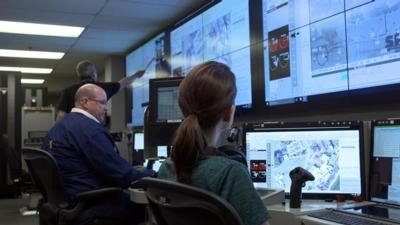Demonstrates Capability To Control UAVs From An Aircraft Carrier
The Navy’s MQ-25 program completed its first demonstration representing how the mission control system located aboard the aircraft carrier will control and transmit information to an unmanned air vehicle in the future.

The April 11 demonstration validated the first build of the MD-5 Unmanned Carrier Aviation Mission Control System (UMCS), a combined hardware and software product, using representative shipboard equipment and a simulated air vehicle at NAS Patuxent River.
Capt. Duarte, PMA-268 program manager, observed the test event and said he was very pleased with the progress the team has made over the last year. The government team worked across multiple program offices, Navy and Air Force commands in addition to industry partners to prepare for the demonstration.
“As Lead Systems Integrator (LSI), we have the ability to really drive interoperability and affordability across the program,” he said. “We have had the opportunity to leverage many existing technologies and capabilities from other Navy platforms and integrate them into this program.”
Within the LSI construct, PMA-268 maintains responsibility for the architecture, configuration, production, development and sustainment of the UMCS. The UMCS hardware builds on NAVSEA Common Display System (CDS) and Common Processing System (CPS) from DDG-1000 and other Aegis ships. It also incorporates the Navy’s Common Control System (CCS), a software architecture managed by PMA-281 that features a common framework, user interface and components designed for use with a variety of unmanned systems.
The PMA-268 team integrated an open mission systems platform to support the reuse of government owned mission management, mission planning and sensor control applications. UMCS 1.0 demonstrated that third party software can coexist with the CCS framework, thereby proving the UMCS architecture is viable, Duarte said.
During the demo, the UMCS communicated with a Mobile Aviation Interoperability Lab (MAIL) truck, simulating a UAV, verifying command and control. The team tested connectivity between the UMCS and shipboard network systems and verified voice trunking (internet protocol to serial) capability between the air vehicle operator and the simulated UAV. The team also performed limited control and data dissemination between the UMCS and simulated UAV to include Automatic Identification System (AIS) detection, Electro-optical/Infrared (EO/IR) Camera operation and dynamic mission re-planning.
“The Surface Aviation Interoperability Lab (SAIL) and System Test & Integration Laboratory (STIL) were integral in making this demonstration a success,” said Jaimie Grubb, UMCS team lead. “By doing demos in the lab first, we are able to prove the control system concept before providing the UMCS to the air system vendor and undergoing test, which provides significant risk reduction as well as schedule and cost savings.”
This demonstration is the first of a continuing, annual series to demonstrate UMCS capabilities as development of the system progresses. Future demonstrations will show the ability to control a small UAS and establish the process for flight and cybersecurity approval s and the integration of software specific to the MQ-25A air vehicle.
The UMCS, part of the MQ-25’s Control System & Connectivity (CS&C) segment, is one component of the system. The MQ-25 effort also includes an air segment and a carrier segment. The program plans to release a request for proposal for the air segment this summer and is working shipboard installations for the carrier segment.
Operationally, the MQ-25 will provide a robust organic refueling capability to make better use of the Navy’s combat strike fighters and extend the range of the carrier air wing. It will also have a secondary intelligence, surveillance and reconnaissance capability.
(Image provided with NAVAIR news release)
 ANN's Daily Aero-Linx (04.16.24)
ANN's Daily Aero-Linx (04.16.24) Aero-News: Quote of the Day (04.16.24)
Aero-News: Quote of the Day (04.16.24) Airborne 04.10.24: SnF24!, A50 Heritage Reveal, HeliCycle!, Montaer MC-01
Airborne 04.10.24: SnF24!, A50 Heritage Reveal, HeliCycle!, Montaer MC-01 Airborne 04.12.24: SnF24!, G100UL Is Here, Holy Micro, Plane Tags
Airborne 04.12.24: SnF24!, G100UL Is Here, Holy Micro, Plane Tags Airborne-Flight Training 04.17.24: Feds Need Controllers, Spirit Delay, Redbird
Airborne-Flight Training 04.17.24: Feds Need Controllers, Spirit Delay, Redbird



